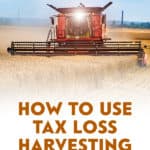How to Use Tax Loss Harvesting to Boost Your Portfolio

For the average Canadian investor, the term tax-loss harvesting might sound complicated, but it’s pretty straightforward, providing that you follow a few rules. In fact, a sound tax-loss harvesting strategy can result in significant tax savings over the years.
How Does Tax Loss Harvesting Work?
Tax-loss harvesting occurs when you sell an investment that has dropped below its original purchase price, triggering a capital loss. The funds are then used to purchase a comparable investment in the hopes that it will increase in value over time, resulting in a capital gain. Any capital losses incurred on an investment can be claimed against capital gains, resulting in tax savings. Because capital gains inside registered accounts (RRSP, TFSA) are not taxed, tax loss harvesting is only for taxable, non-registered investment accounts.
Capital losses can be used to reduce capital gains in the current year, the three preceding years, or in any future year. For example, if you sold an investment at a $20,000 loss during the 2020 tax year, but didn’t have a capital gain from the same year or any of the three preceding years, the loss can sit there, available to be used against future capital gains.
The CRA Superficial Loss Rule
There are some guidelines you need to follow to execute a tax harvesting loss properly. If you don’t, you may end up in trouble with the CRA, or wasting a tax savings opportunity. For example, after selling an investment for a loss, you cannot immediately repurchase the same investment at a lower price. This will trigger the CRA’s ‘superficial loss’ rule, which prevents the repurchase of the same security within 30 days. The rule exists to prevent investors from gaming the system in order to avoid paying income taxes.
Yes, you could wait the 30 days, but you never know what will happen in the markets during that time. You could miss out on a major spike in the markets. Instead, what you want to do is purchase a comparable investment that should provide a similar return over the long run.
Tax Loss Harvesting ETF Example
I’ll use the following example to explain how tax-loss harvesting might work inside an ETF portfolio (not actual returns, for illustration only):
You invested $25,000 in the BMO S&P TSX Capped Composite Index ETF (ZCN) in 2019, but the value has since dropped to $20,000. The funds are in a non-registered account, so you decide to sell the investment and reinvest $20,000 into a comparable ETF, the Vanguard FTSE Canada All Cap Index fund (VCN). The funds track a different index but have similar holdings. The MERs are identical, at .06%, making the Vanguard fund a logical alternative.
By realizing the capital loss on ZCN, you are now able to tax loss harvest up to $5000 against future capital gains on VCN. And because the funds are very comparable (Canadian equity ETFs), you can expect to see similar returns over the long term.
Tax Loss Harvesting and Portfolio Rebalancing
Unfortunately, a lot of Canadians have thousands of dollars wrapped up in high-cost investments. Any actively traded mutual fund is a good example, with management fees that are often over 2%. It’s almost never a bad time to switch out a high fee investment and rebalance using a low-cost alternative, like an ETF, but tax-loss harvesting can make it an even more attractive proposition. You have an opportunity to save on taxes and reduce your investment costs at the same time.
Let’s say you have a Canadian Equity mutual fund that has a current market value of $85,000 and an original purchase amount of $100,000. You’re paying a hefty 2.30% annual fee to the fund manager. You can stay invested and hope that your investment can overcome it’s own high fees and eventually return to positive ground, or you can sell the fund, realize a capital loss of $15,000, and replace it with a low cost ETF that is also invested in Canadian equities.
Not only will you save over 2% per year in fees by rebalancing into the ETF, but when the markets rebound, you’ll also have $15,000 of tax-free growth to play with. That’s enough to soften the blow of investing in high fee mutual funds in the first place.
Tax Loss Harvesting Pros
When dealing with capital gains and losses on your taxable investment accounts, there are a lot of things to consider. To help, here’s a bullet point list of tax-loss selling advantages:
- Reduce taxes in non-registered investment accounts
- Minimizes the negative impact of losses inside your portfolio
- Integrate with portfolio rebalancing to improve your asset mix
- Can be used strategically to save on taxes in future years
- Automated tax loss selling available via robo-advisor
Best Accounts to Tax Loss Harvest
Any DIY investor with a discount brokerage account can do their own tax-loss harvesting, however, keeping track of everything on your own can be tough. There are two companies I know of that take a lot of the work out of tax-loss harvesting: Questrade and Wealthsimple.
Questrade is a popular Canadian discount brokerage, in fact, it’s our top-rated online broker here at MapleMoney. It’s easy to use and offers some of the lowest fees in the business, including no-fee ETF purchases. Questrade portfolio managers implement a tax-loss harvesting strategy inside their very own Questwealth portfolios. If you don’t mind some automating of your investments, it’s worth checking out.
The Wealthsimple name is synonymous with robo-advisor investing in Canada. If you have a minimum balance of $100,000 in your portfolio, you qualify for Wealthsimple Black service. If your balance is $500,000 or more, it’s called Wealthsimple Generation. Both of these plans include automated tax-loss harvesting. Not only are you benefitting from low fees and hands-off investing, but you also benefit from additional tax savings opportunities in your taxable accounts.
If you’re not using a hands-off approach like the ones offered by Questrade or Wealthsimple, I recommend that you consult with a tax professional before implementing your own tax-loss harvesting strategy.
The Bottom Line on Tax Loss Harvesting
Canadians are fortunate to have so many tax-sheltered investment options, including RRSPs, RESPs, and TFSAs. The best way to pay less tax on your investments is by maximizing your available contribution room in these registered accounts. Once you’ve done that, tax loss harvesting is a great way to find additional tax savings inside a taxable account. No one should take capital losses blindly, however. Look for opportunities to rebalance high fee investments that have dropped in value, and never take a superficial loss.
If you have capital gains from current or past years, consider using your capital losses to offset those first. If you don’t mind giving up a little control, I highly recommend the automated tax-loss selling strategies offered by Questrade and Wealthsimple. Lastly, if you decide to look after your own tax-loss harvesting, make sure you consult with a tax professional first.


Comments
Great article Mr. Drake. You have an interesting take on the investment angle of tax losses.
I am a former CRA auditor/appeals officer/technical advisor. You are correct on the tax treatment of Superficial Losses. Your readers might be interested to know that the superficial losses if denied can be added to the adjusted cost base of the shares thereby reducing the capital gain on eventual disposition.